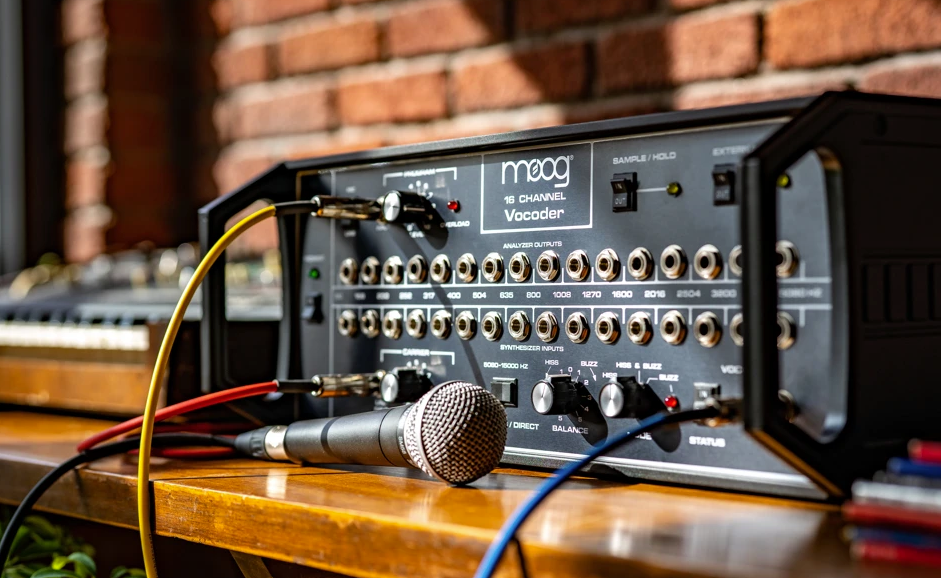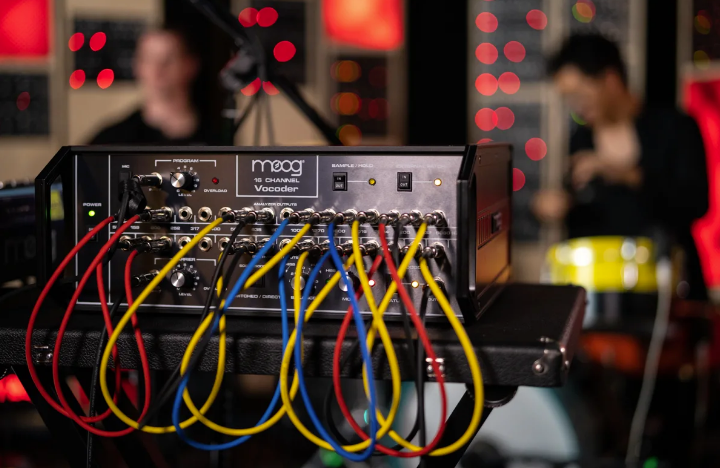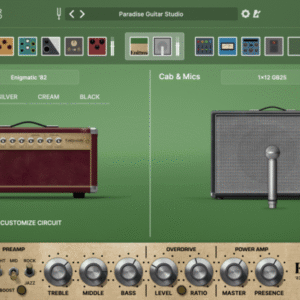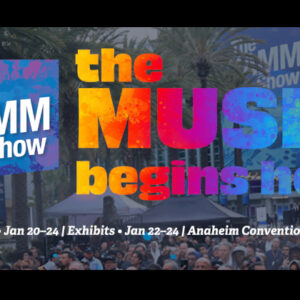
We only recommend products that we use and believe in. When you purchase through links on our site, we may earn an affiliate commission.
After more than 40 years, Moog Music has resumed production of the highly sought-after Moog 16 Channel Vocoder. To help welcome the instrument’s return, Moses Sumney visited the Moog Sound Lab to perform an unreleased track from his upcoming double album græ.
The history of the vocoder is as unique as the sound it produces.
In the 1930s, Bell Labs introduced the technology as a telecommunications device that could deconstruct the most fundamental elements of human speech and then reconstruct a new electronically synthesized voice. During WWII, the US military used this advancement to electronically encode classified audio messages that could be reconstituted on the receiving end.

Over the following decades, music technologies would explore the artistic applications of the vocoder, whose robotic vocal articulations would soon find their way into mainstream music, television, films, and games. The influential sound machine has been used by the likes of Stevie Wonder, Herbie Hancock, Dr. Dre, Kraftwerk, Daft Punk and many more.
Moog 16 Channel Vocoder, originally introduced in 1978 (and heard most famously onthe title track of Giorgio Moroder’s E=MC2), has been used to transmute vocals, transform synthesizers, and electronically encode sound for decades.

With the instrument’s reintroduction, Moog Music has gone to great lengths to ensure that this distinct electronic voice carries on. Derived from the original schematic, the Moog 16 Channel Vocoder’s analog voice circuits are hand-soldered at the Moog Factory in Asheville, North Carolina to preserve the original instrument’s classic sound. Updated mechanical connectors and a modern power supply improve reliability and long-term serviceability while ensuring that the analog soul of this instrument—and its unique character and idiosyncrasies—remains unchanged.
Moses Sumney, accompanied by a full band, recently visited the Moog Sound Lab in Asheville, North Carolina to perform a reimagination of “Conveyor” from his forthcoming album græ.
In this rendition of the unreleased track, Sumney processes his vocals through the Moog 16 Channel Vocoder, using the Matriarch synthesizer to serve as the vocoder’s carrier signal in order to transform and resynthesize his voice. Sumney also incorporates a looper pedal to manipulate both the dry and vocoded vocals, creating rhythmic patterns throughout the track. He is accompanied by Zach Cooper on bass, Mike Haldeman on guitar, Darian Thomas on violin, and Ian Chang on drums and sensory percussion.
Moses Sumney’s upcoming release includes collaborations with a diverse array of contributors and is his first work to be written in his new home of Asheville, North Carolina—also the home of Moog Music Inc. Double LP græ will be released via Jagjaguwar Records, with the first part due digitally this month; the second part, as well as the physical album, will be available May 15th. To pre-order græ, and for more info about Moses Sumney, visit mosessumney.com.
Now Available at Select Dealers Worldwide
The Moog 16 Channel Vocoder is crafted with care by the employee-owners at Moog Music in Asheville, North Carolina. The Moog 16 Channel Vocoder, which has been used to encode sound, transmute vocals, and transform synthesizers for over 40 years, is now available for order with select Moog authorized dealers worldwide. Locate a dealer near you to order your instrument: www.moogmusic.com/dealers.

More About the Moog 16 Channel Vocoder
The instrument works by continuously analyzing the timbral characteristics of one sound (program) and impresses these timbral characteristics upon a second signal (carrier).
16 Bands: The Moog 16 Channel Vocoder offers 16 patchable bands ranging from 50 to 5,080 Hz for optimal encoding of the fundamental spectral characteristics of the human voice. In addition, a selectable DIRECT mode passes an additional high frequency channel (above 5,080 Hz) to the vocoder output for a greater degree of vocal intelligibility. While traditionally associated with vocal effects, the Moog 16 Channel Vocoder’s ultra fast response time makes it additionally useful for capturing the fast transients of percussive sounds.
Sample & Hold: When you articulate a sound and press the Sample/Hold switch, the tonal characteristics of that sound will be held until the switch is returned to the out position. This function is particularly useful in creating sustained vocal phrases without pausing for breath and can be controlled via remote footswitch.
External Patch: Use the included patch cords to interconnect this powerful vocoder with other analog gear, or create unusual “cross patches,” allowing you to select any frequency range of the program and impose those characteristics upon any frequency range of the carrier.
Hiss, Buzz, and Balance: Selectable Hiss (sibilance), Buzz (plosive), and Balance controls allow you to fine-tune the fundamental details of your electronic voice.
Footswitch Operation: The Sample/Hold, External Patch, and effect Status parameters may be remotely controlled for live performance via footswitch.
Learn more about the Moog 16 Channel Vocoder at www.moogmusic.com/products/16-channel-vocoder.




cool